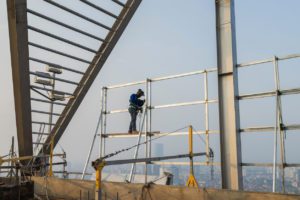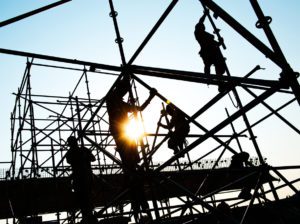










Have you suffered an injury in a scaffolding accident in Boston, MA? You may be entitled to workers’ compensation benefits or damages in a third-party claim. The Boston scaffolding accident lawyers will work with you to get you the most money available for your injury claim.
Our lawyers have over 100 years of combined legal experience. We understand the complex laws related to construction site accidents. For decades, we have been fighting for the rights of accident victims to receive fair compensation.
Call our team today at (617)-391-9001 or fill out out contact form to schedule a free consultation. You can discuss your case with one of our construction accident lawyers in Boston free of charge.

Injuries and accidents can turn your life upside down. You may be out of work for months as you recover from your injury. We understand the financial crisis that a scaffolding accident can cause.
Sweeney Merrigan Personal Injury Lawyers have over 100 years of combined legal experience. We use the skills, resources, and expertise developed over decades to fight for our clients’ best interests.
Our legal team has recovered hundreds of millions in awards for our clients. We do not stop fighting until all sources of compensation for damages are exhausted.
When you hire our legal team, you can expect us to:
Seeking legal advice from an experienced personal injury lawyer in Boston, Massachusetts, is the first step in protecting your best interests after a scaffolding accident.
Call our Boston scaffolding accident attorneys now to request your free consultation with a Boston construction accident lawyers.

Many scaffolding accidents each year take place in the construction industry. Scaffolding is a necessary tool used in construction to allow workers to reach levels that a ladder will not reach. Scaffolds allow for repairs and other projects on existing buildings.
The Occupational Safety & Health Administration (OSHA) reports that about 65 percent of construction workers use scaffolds as part of their job. Each year, over 60 people die and more than 4,500 individuals are injured in scaffolding accidents.
Construction companies and contractors use many types of scaffolds, including supported scaffolds on high buildings throughout Boston. Workers using that scaffolding could be at risk for injuries and life-threatening conditions.
A scaffold is a temporary work platform workers use to elevate themselves, equipment, and materials. Workers may stand or sit on the platform as they work at heights way above the ground. Scaffolding may be constructed from various materials, including wood and metal.
Scaffolds may be constructed from the ground or suspended from the roof. Scaffolding constructed from the ground increases in height as the construction progresses upward. Improper scaffold construction or faulty materials can fail, injuring construction workers. Commonly, the end result of a scaffolding accident is a personal injury or a wrongful death claim. Personal injury is when the victim is injured but does not pass away. If the victim does pass away as a direct result of the injury, the surviving family is eligible to file for a wrongful death claim.
A BLS study revealed that almost three-fourths of scaffolding accidents could be attributed to one of three causes:

Platforms might give way and injure workers because of improper assembly, inadequate maintenance, or defective equipment. A lack of guardrails and slippery surfaces can also contribute to a slip-and-fall scaffolding accident, as well as an inadequate ladder. Ladder accidents may cause electrical burns and electrocution if the ladder comes into contact with a live current. Wrongful death is common when a worker falls from a high elevation.
Other causes of scaffolding accidents include:
Errors and negligence when use scaffolding can lead to serious injuries on a construction site or job site.
Because of the height of the work area, scaffolding accidents can result in traumatic injuries and fatalities.
Common scaffolding accident injuries include:
It is important to remember that other individuals could be injured because of a scaffolding accident. Other workers and pedestrians could be injured if the scaffolding collapses or items fall from the scaffolding.

Depending on the cause of the scaffolding accident, one or more parties could be liable for damages, including lost wages.
If the construction accident occurred during the ordinary course of employment, the injury might be covered by Massachusetts workers’ compensation insurance. In many cases involving ladders or other work-provided equipment, the employer is considered liable. Workers do not need to prove negligence or fault to receive workers’ compensation benefits.
Scaffolding manufacturers might be liable for damages if the accident occurred because of a defective product. General contractors and installers may be liable for damages if we fail to install the scaffolding correctly. Property owners could also be liable for a scaffolding accident if a dangerous condition on the property contributed to the cause of the accident.
Determining who is liable for your damages could be difficult unless you can identify the cause of the scaffolding accident. Our Boston scaffolding accident lawyers work with engineers and other experts to investigate the cause of the accident.
Identifying each party who could be liable for your damages is crucial. It increases your chance of receiving maximum compensation for damages with the help of your Boston ladder accident attorney.
At Sweeney Merrigan Personal Injury Lawyers, our lawyers have significant experience handling scaffolding accidents and wrongful death claims. We understand the complexities associated with these types of personal injury claims and have devoted years to helping our clients get the compensation they deserve. Erin E. McHugh, named a 2022 Rising Star by Super Lawyers, has been instrumental in securing clients millions of dollars in personal injury claims.
If you were injured in a scaffolding accident, please contact the experienced personal injury lawyers at Sweeney Merrigan Personal Injury Lawyers for a free consultation. You can reach us through our contact form or at 617-391-9001. It does not cost you anything to learn about your legal rights and discuss your options for recovering the compensation you deserve.
Attorneys at Sweeney Merrigan Law, LLP have been recognized and honored by several of the top legal associations, including SuperLawyers, National Trial Lawyers Association, and Best Lawyers.
Sweeney Merrigan Law, LLP is a highly successful personal injury law firm serving Massachusetts since 2011.
There are no fees or costs unless we win your case!
We use cookies on our site to analyze traffic, enchance your experience, and provide you with tailored content.
For full functionality of this site, you must consent to the use of cookies. For more information or to opt out, visit our privacy policy